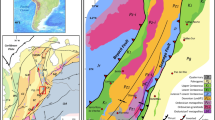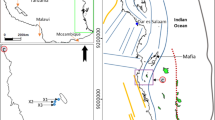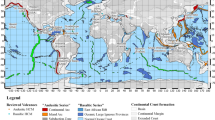Abstract
Deep-water siliciclastic systems are classified primarily on their shape as: submarine fans with well developed or poorly developed morphology, slope drapes, for example, over relatively stable basin margins, fault-scarp aprons, canyons and large channels, under-supplied sheet systems such as abyssal plains, non-fan ponded systems such as over-supplied perched basins, and fan deltas. Collectively, or separately, these systems may form sedimentary basin fills that can be over or under-supplied with respect to the sediment input although most systems will tend toward over-supply/overflow with time. Finally, the sum total of the siliciclastic systems and basins can be used to define the tectonic milieux such as passive, strike-slip and convergent margins.
Similar content being viewed by others
References
Hiscott, R. N., 1980. Depositional framework of sandy mid-fan complexes of the Tourelle Formation, Ordovician, Quebec. American Association of Petroleum Geologists Bulletin, v. 64, p. 1052–1077.
Mutti, E., and Ricci Lucchi, F., 1972. Le torbiditi dell' Appennino settentriole: introduzione all'analisi di facies. Memorie della Societa Geologica Italiana, v. 11, p. 161–199.
Mutti, E., and Ricci Lucchi, F., 1974. La signification de certaines unites sequentielles dans les series a turbidites. Bulletin de la Societe geologique de France, v. 16, p. 577–582.
Normark, W. R., 1978. Fan valleys, channels, and depositional lobes on modern submarine fans: characters for recognition of sandy turbidite environments. American Association of Petroleum Geologists Bulletin, v. 62, p. 912–931.
Walker, R. G., 1978. Deep-water sandstone facies and ancient submarine fans: models for exploration for stratigraphic traps. American Association of Petroleum Geologists Bulletin, v. 62, p. 932–966.
Mutti, E., and Ricci Lucchi, F., 1978. Turbidites of the Northern Apennines: introduction to facies analysis. International Geology Review, v. 20, p. 125–166 (translated by Tor H. Nilsen, U.S. Geological Survey).
Surlyk, F., 1978. Submarine fan sedimentation along fault scars on tilted fault blocks (Jurassic-Cretaceous boundary, East Greenland). Grönlands Geologiske Undersøgelse, Bulletin No. 128, 108 p.
Schweller, W. J., and Kulm, L. D., 1978. Depositional patterns and channelized sedimentation in active Eastern Pacific trenches. In: D. J. Stanley and G. Kelling (eds.), Submarine Canyons, Fans, and Trenches. Dowden, Hutchinson & Ross, Stroudsburg, Pa., p. 311–324.
Mutti, E., 1977. Distinctive thin-bedded turbidite facies and related depositional environments in the Eocene Hecho Group (south-central Pyrenees). Sedimentology, v. 24, p. 107–131.
Ricci Lucchi, F., 1975. Depositional cycles in two turbidite formations of the Northern Apennines (Italy). Journal of Sedimentary Petrology, v. 45, p. 3–43.
Niem, A. R., 1976. Patterns of flysch deposition and deep-sea fans in the Lower Stanley Group (Mississippian), Ouachita Mountains, Oklahoma and Arkansas. Journal of Sedimentary Petrology, v. 46, p. 633–646.
Maldonado, A., and Stanley, D. J., 1979. Depositional patterns and Late Quaternary evolution of two Mediterranean submarine fans: a comparison. Marine Geology, v. 31, p. 215–250.
Mutti, E., 1979. Turbidites et cones sous-marins profunds. In: P. Homewood (ed.), Sedimentation Detritique (Fluviatile, Littorale et Marine). Institute of Geology, University of Fribourg, p. 353–419.
Doyle, L. J., Pilkey, O. H., and Woo, C. C., 1979. Sedimentation on the Eastern United States Continental Slope. In: L. J. Doyle and O. H. Pilkey (eds.), Geology of Continental Slopes. Society of Economic Paleontologists and Mineralogists Special Publication No. 27, p. 119–129.
Schlee, J. S., Dillon, W. P., and Grow, J. A., 1979. Structure of the contimental slope off the eastern United States. In: L. J. Doyle and O. H. Pilkey (eds.), Geology of Continental Slopes. Society of Economic Paleontologists and Mineralogists Special Publication No. 27, p. 95–117.
Booth, J. S., 1979. Recent history of mass-wasting on the upper continental slope, northern Gulf of Mexico, as interpreted from the consolidation states of the sediment. In: L. J. Doyle and O. H. Pilkey (eds.), Geology of Continental Slopes. Society of Economic Paleontologists and Mineralogists Special Publication No. 27, p. 153–164.
Cook, H. E., 1979. Ancient continental slope sequences and their value in understanding modern slope development. In: L. J. Doyle and O. H. Pilkey (eds.), Geology of Continental Slopes. Society of Economic Paleontologists and Mineralogists Special Publication No. 27, p. 287–305.
Dott, R. H. Jr., and Bird, K. J., 1979. Sand transport through channels across and Eocene shelf and slope in southwestern Oregon, U.S.A. In: L. J. Doyle and O. H. Pilkey (eds.), Geology of Continental Slopes. Society of Economic Paleontologists and Mineralogists Special Publication No. 27, p. 327–342.
Pickering, K. T., 1982. A Precambrian upper basin-slope and prodelta in northeast Finnmark, North Norway-a possible ancient upper continental slope. Journal of Sedimentary Petrology, v. 52, p. 171–186.
Buffler, R. T., Watkins, J. S., and Dillon, W. P., 1979. Geology of the Offshore Southeast Georgia Embayment, U.S. Atlantic Continental Margin, Based on Multichannel Seismic Reflection Profiles. In: J. S. Watkins, L. Montadert and P. W. Dickerson (eds.), Geological and Geophysical Investigations of Continental Margins. American Association of Petroleum Geologists Memoir 29, p. 11–25.
Field, M. E., and Clarke, S. H. Jr., 1979. Small-scale slumps and slides and their significance for basin slope processes, southern California Borderland. In: L. J. Doyle and O. H. Pilkey (eds.), Geology of Continental Slopes. Society of Economic Paleontologists and Mineralogists Special Publication No. 27, p. 223–230.
Nardin, T. R., Edwards, B. D., and Gorsline, D. S., 1979. Santa Cruz Basin, California Borderland: dominance of slope processes in basin sedimentation. In: L. J. Doyle and O. H. Pilkey (eds.), Geology of Continental Slopes. Society of Economic Paleontologists and Mineralogists Special Publication No. 27, p. 209–221.
Reading, H. G., 1980. Characteristics and recognition of strikeslip fault systems. In: P. F. Ballance and H. G. Reading (eds.), Sedimentation in Oblique-Slip Mobile Zones. International Association of Sedimentologists Special Publication No. 4, p. 7–26.
Norris, R. J., Carter, R. M., and Turnbull, I. M., 1978. Cenozoic sedimentation in basins adjacent to a major continental transform boundary in southern New Zealand. Journal of the Geological Society of London, v. 135, p. 191–205.
Kepper, J. C., 1981. Sedimentology of a Middle Cambrian outer shelf margin with evidence for syndepositional faulting, Eastern California and Western Nevada. Journal of Sedimentary Petrology, v. 51, p. 807–821.
Fail, J. P., 1979. Structure and development of the Southeast Georgia Embayment and Northern Blake Plateau: preliminary analysis. In: J. S. Watkins, L. Montadert and P. W. Dickerson (eds.), Geological and Geophysical Investigations of Continental Margins. American Association of Petroleum Geologists Memoir 29, p. 27–41.
Neves, R., and Selley, R. C., 1975. A review of the Jurassic rocks of NE Scotland. In: K. G. Finstad and R. C. Selley (eds.), Proceedings: Jurassic Northern North Sea Symposium. Stavanger, JNNSS/5, Norsk Petroleumsforening.
Selley, R. C., 1976. The habitat of North Sea Oil. Proceedings of the Geologists Association, v. 87, p. 359–387.
Pickering, K. T., (In press). Small scale synsedimentary faults in the Upper Jurassic ‘Boulder Beds’. Scottish Journal of Geology.
Kent, P., 1974. Continental margin of East Africa—A region of vertical movements. In: C. A. Burk and C. L. Drake (eds.), The Geology of Continental Margins. Springer-Verlag, New York, p. 313–320.
Renard, V., and Mascle, J., 1974. Eastern Atlantic continental margins: various structural and morphological types. In: C. A. Burk, and C. L. Drake (eds.), The Geology of Continental Margins. Springer-Verlag, New York, p. 285–291.
McGregor, B., and others, 1982. Wilmington Submarine Canyon: A marine fluvial-like system. Geology, v. 10, p. 27–30.
Stubblefield, W. L., and others, 1982. Reconnaissance in DSRV Alvin of a “fluvial-like” meander system in Wilmington Canyon and slump features in South Wilmington Canyon. Geology, v. 10, p. 31–36.
McGregor, B. A., 1981. Smooth seaward-dipping horizons-an important feature in seafloor stability? Marine Geology, v. 39, p. M89-M98.
Chough, S., and Hesse, R., 1976. Submarine meandering thalweg and turbidity currents flowing for 4000 km in the northwest Atlantic mid-ocean channel. Labrador Sea. Geology, v. 4, p. 529–533.
Picha, F., 1979. Ancient submarine canyons of Tethyan continental margins, Czechoslovakia. American Association of Petroleum Geologists Bulletin, v. 63, p. 67–86.
Underwood, M. B., and Karig, D. E., 1980. Role of submarine canyons in trench and trench-slope sedimentation. Geology, v. 8, p. 432–436.
Rupke, N. A., 1976. Large-scale slumping in a flysch basin, south-western Pyrenees. Journal of the Geological Society of London, v. 132, p. 121–130.
Hein, F., and Walker, R. G., 1982. The Cambro-Ordovician Cap Enragé Formation, Québec, Canada: conglomeratic deposits of a braided submarine channel with terraces. Sedimentology, v. 29, p. 309–329.
Berger, W. H., 1974. Deep-sea sedimentation. In: C. A. Burk and C. L. Drake (eds.), The Geology of Continental Margins. Springer-Verlag, New York, p. 3–10.
Scholl, D. W., 1974. Sedimentary sequences in the North Pacific trenches. In: C. A. Burk and C. L. Drake (eds.), The Geology of Continental Margins. Springer-Verlag, New York, p. 493–504.
Dickinson, W. R., and Seely, D. R., 1979. Structure and stratigraphy of forearc regions. American Association of Petroleum Geologists Bulletin, v. 63, p. 1–31.
Flood, R. D., and Hollister, C. D., 1974. Current-controlled topography on the continental margin off the Eastern United States. In: C. A. Burk and C. L. Drake (eds.), The Geology of Continental Margins. Springer-Verlag, New York, p. 197–205.
Uyeda, S., 1974. Northwest Pacific trench margins. In: C. A. Burk and C. L. Drake (eds.), The Geology of Continental Margins. Springer-Verlag, New York, p. 473–491.
Karig, D. E., and others, 1979. Structure and Cenozoic evolution of the Sunda Arc in the Central Sumatra Region. In: J. S. Watkins, L. Montadert and P. W. Dickerson (eds.), Geological and Geophysical Investigations of Continental Margins. American Association of Petroleum Geologists Memoir 29, p. 223–237.
Buffler, R. T., and others, 1979. Anatomy of the Mexican Ridges, Southwestern Gulf of Mexico. In: J. S. Watkins, L. Montadert and P. W. Dickerson (eds.), Geological and Geophysical Investigations of Continental Margins. American Association of Petroleum Geologists Memoir 29, p. 319–327.
Underwood, M. B. and Bachman, S. B., 1982. Sedimentary facies associations within subduction complexes. In: J. K. Leggett (ed.), Trench-Forearc Geology. Special Publication of the Geological Society of London No. 10, p. 537–547.
Klitgord, K. D., and Behrendt, J. C., 1979. Basin structure of the U.S. Atlantic Margin. In: J. S. Watkins, L. Montadert and P. W. Dickerson (eds.), Geological and Geophysical Investigations of Continental Margins. American Association of Petroleum Geologists Memoir 29, p. 85–112.
Wescott, W. A., and Ethridge, F. G., 1982. Bathymetry and sediment dispersal dynamics along the Yallahs Fan Delta Front, Jamaica. Marine Geology, v. 46, p. 245–260.
Ricci Lucchi, F., and others, 1981. Pliocene fan deltas of the Intra-Apenninic Basin, Bologna. In: F. Ricci Lucchi (ed.), Excursion guidebook with contributions on sedimentology of some Italian basins. International Association of Sedimentologists 2nd European Regional Meeting, Bologna, Italy, p. 79–162.
Carter, L., Carter, R. M., and Griggs, G. B., 1982. Sedimentation in the Conway Trough, a deep near-shore marine basin at the junction of the Alpine transform and Hikurangi subduction plate boundary, New Zealand. Sedimentology, v. 29, p. 475–497.
Malouta, D. N., Gorsline, D. S., and Thornton, S. E., 1981. Processes and rates of Recent (Holocene) basin filling in an active transform margin: Santa Monica Basin, California Borderland. Journal of Sedimentary Petrology, v. 51, p. 1077–1095.
Author information
Authors and Affiliations
Rights and permissions
About this article
Cite this article
Pickering, K.T. The shape of deep-water siliciclastic systems: A discussion. Geo-Marine Letters 2, 41–46 (1982). https://doi.org/10.1007/BF02462798
Received:
Revised:
Issue Date:
DOI: https://doi.org/10.1007/BF02462798




